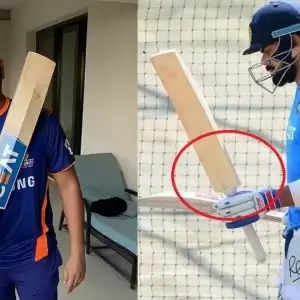Who Manufactures Virat Kohli And Rohit Sharma’s Bats?: In the second Test between India and South Africa, in Johannesburg, KL Rahul, the stand-in captain and Man of the Match in the first Test, was seen batting without a sticker at the front of his bat.
Rahul had signed a sponsorship deal with Meerut-based SG (Sanspareils Greenlands), however, it is believed that his deal had ended at the turn of the year and hence hasn’t been using their sticker at the front of his bat in games this year so far.
Often a batsman gets remembered with his bat sponsor during his glory days – say, Sachin Tendulkar and Adidas in the last quarter of his career, Rahul Dravid with Britannia, Virat Kohli with MRF, Rohit Sharma with CEAT.

But, these are not bat manufacturing companies. These are brands that pay a hefty sum to the batters to put their sticker or logo on their willow. It is, indeed, the bat manufacturers who don’t get their recognition.
A 2016 study revealed that India manufactures 95% of the bats used by international cricketers, and has a cricket equipment industry that was estimated to be worth Rs 350 crore. Bright, emerging players generally earn contracts with manufacturers from a young age.
The bat-making companies scout for talented cricketers in the domestic circuit and offer them contracts in return for the players using their logo for the specific period of the contract, making it beneficial to both the player, who starts to make money at a young age, and the manufacturing company, who gets recognition when the player scales height.
This practice was the norm until Kapil Dev signed a contract with Power in the late 1980s bringing a revolution. India’s World Cup-winning captain received a handsome amount sum for using the Power logo on his bats.
Since then, the renowned players would sign two contracts, one with the manufacturer for equipment and another with a sticker sponsor for income. Top-tier brands like MRF, Hero Honda, Reebok and Britannia became household names with their logo appearing on the bats on some of India’s finest.
However, this change wasn’t appreciated by the bat manufacturers and they approached the ICC in the early 2000s to get more recognition for their products, but their appeal wasn’t given heed by the governing body.
The bat manufacturers couldn’t go cross with the player as there would be competitors lining up to provide their service to the cricketer.
But, they would eventually find a way to tackle this issue and make revenue. The manufacturers developed a system that brought them income, if not recognition, through their association with players.
Earlier, players would have small stickers or engravings of the manufacturer’s label on the side or bottom of the bat and therefore, manufacturers wouldn’t charge players any money for supplying them with bats.
Now, this same strategy has become an excellent marketing aspect because even a small label on the side of a big-name cricketer would get noticed by other cricketers and the public.
While players decided to have only sponsored labels on their bats, manufacturers decided to charge the MRP for each bat. So now, a sponsor could buy dozens of bats in bulk for its client and then go ahead and replace the logo.
The ICC allows any company – for example, MRF, CEAT, Nike, Adidas, Puma, Reebok, etc. – to purchase bats from manufacturers like SG, SS, BDM, BAS, etc., and put their own labels on the bats and market them.
In 2017, the then India captain Virat Kohli signed an enormous deal with MRF for over Rs 100 crore for 8 years, bringing profits to all the parties involved.
So the next time you are out looking at an MRF bat and thinking, “Jeez, I’m gonna get myself one of those ‘coz King Kohli uses it.” Then remember, MRF – which is the largest tyre manufacturer in India – doesn’t make bats; they buy them from a manufacturer and sell with their brand label pasted on them.



